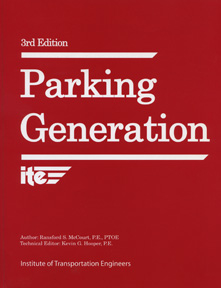Pursuing SSc4.4: Alternative Transportation—Parking Capacity in the LEED 2009 NC, CS, and Schools rating systems just got a little more expensive for some projects—$118.75 more to be exact.
The April 2010 LEED Addenda outlines a new “Option 4” for non-residential projects SSc4.4. Now if your project lacks local zoning codes for parking capacity you’ll need to purchase a copy of the 2003 Institute of Transportation Engineers (ITE) Parking Generation study. Rest assured, this book is has plenty of information to back up its price tag. However, the amount you’ll use on just one project is minimal.
 Parking Generation is a compilation of parking capacity data collected by volunteers through surveys (samples of which are in Appendix C of the study). While it’s interesting and informative, delving into Parking Generation may seem a bit daunting. Data is organized into approximately 200 charts and graphs; of which only one figure per page is essential for your purposes, the rest, frankly, is just for your information. The study is broken down into 91 Land Use types; such as Manufacturing, Hotel, Marina, Library, Office Building, Apparel Store, and Dry Cleaners. Each Land Use type has at least one report; many have multiple reports organized by hour of day, day of week, month of year, area type, weekday, weekend or peak periods.
Parking Generation is a compilation of parking capacity data collected by volunteers through surveys (samples of which are in Appendix C of the study). While it’s interesting and informative, delving into Parking Generation may seem a bit daunting. Data is organized into approximately 200 charts and graphs; of which only one figure per page is essential for your purposes, the rest, frankly, is just for your information. The study is broken down into 91 Land Use types; such as Manufacturing, Hotel, Marina, Library, Office Building, Apparel Store, and Dry Cleaners. Each Land Use type has at least one report; many have multiple reports organized by hour of day, day of week, month of year, area type, weekday, weekend or peak periods.
Your first task is to figure out which Land Use category your project falls under. These are listed in the Table of Contents organized into larger categories such as 300 Lodging and 800 Retail; making this step much simpler. (You can view the table of contents online at www.ite.org.)
Let’s say your project is an elementary school. You’ll find it under 100 Institutional, and the Land Use code is 520. The corresponding report takes into consideration “…busing policies, the availability of adequate parent pick-up/drop off zones, and lack of adequate parking.” Data to support the recommendations was collected from 7 a.m. to 10 a.m. as well as 2 p.m. to 5 p.m. and it is assumed that the school is centrally located in a residential area. The elementary school report uses “Average Peak Period Parking Demand” versus student numbers on a weekday.
 According to the report, the Average Peak Period is 3–4 p.m.; the Average Peak Period Parking Demand is 0.28 vehicles per student. So to achieve SSc4.4 under this compliance path you need to provide 25% less than 0.28 vehicles per student—that’s 0.21 vehicles per student.
According to the report, the Average Peak Period is 3–4 p.m.; the Average Peak Period Parking Demand is 0.28 vehicles per student. So to achieve SSc4.4 under this compliance path you need to provide 25% less than 0.28 vehicles per student—that’s 0.21 vehicles per student.
If your elementary school has 500 students, you would need to have no more than 105 parking spaces to earn this credit. The simplicity of this calculation and the fact that it spits out an exact number is particularly useful and may save a lot of time.
Parking Generation is not a LEED-specific text, so it has applications outside of LEED, for any project seeking parking capacity guidance.
Purchasing the book (available in softcover, with no PDF version available) will make your first project slightly more expensive, but it could save you time (and therefore money) in the future.

 Parking Generation is a compilation of parking capacity data collected by volunteers through surveys (samples of which are in Appendix C of the study). While it’s interesting and informative, delving into Parking Generation may seem a bit daunting. Data is organized into approximately 200 charts and graphs; of which only one figure per page is essential for your purposes, the rest, frankly, is just for your information. The study is broken down into 91 Land Use types; such as Manufacturing, Hotel, Marina, Library, Office Building, Apparel Store, and Dry Cleaners. Each Land Use type has at least one report; many have multiple reports organized by hour of day, day of week, month of year, area type, weekday, weekend or peak periods.
Parking Generation is a compilation of parking capacity data collected by volunteers through surveys (samples of which are in Appendix C of the study). While it’s interesting and informative, delving into Parking Generation may seem a bit daunting. Data is organized into approximately 200 charts and graphs; of which only one figure per page is essential for your purposes, the rest, frankly, is just for your information. The study is broken down into 91 Land Use types; such as Manufacturing, Hotel, Marina, Library, Office Building, Apparel Store, and Dry Cleaners. Each Land Use type has at least one report; many have multiple reports organized by hour of day, day of week, month of year, area type, weekday, weekend or peak periods. According to the report, the Average Peak Period is 3–4 p.m.; the Average Peak Period Parking Demand is 0.28 vehicles per student. So to achieve SSc4.4 under this compliance path you need to provide 25% less than 0.28 vehicles per student—that’s 0.21 vehicles per student.
According to the report, the Average Peak Period is 3–4 p.m.; the Average Peak Period Parking Demand is 0.28 vehicles per student. So to achieve SSc4.4 under this compliance path you need to provide 25% less than 0.28 vehicles per student—that’s 0.21 vehicles per student.
Add new comment
To post a comment, you need to register for a LEEDuser Basic membership (free) or login to your existing profile.